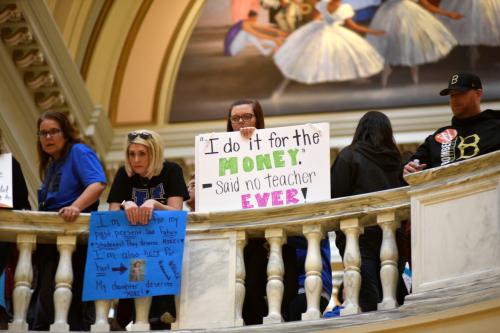Low teacher pay has attracted much attention over the last year in the wave of teacher unrest, even gathering attention among Democratic presidential candidates. A recent report from The Economic Policy Institute shows teachers were paid lower than other college graduates in all states, and the teacher pay penalty in the U.S. is also large by international standards.
Yet, most conversations fail to acknowledge that teacher wage penalties differ quite markedly between teachers of different disciplines. Individuals with degrees in science, technology, engineering, and mathematics (STEM) fields are hit the hardest when they choose to enter teaching over other careers in their field. Since the STEM teacher pipeline relies heavily on STEM graduates, the large wage penalty faced by these graduates impacts the size and quality of the STEM teacher workforce.
The importance of qualified teachers and the trouble finding them
By now, the public is well aware of the role of teacher shortages in the recent teacher actions. Shortages are a signal that the country’s supply of teachers does not currently meet its demand. Yet, the public may not be aware that these shortages vary widely and are most acute in specific subjects: namely, special education and STEM fields. Setting aside the separate issues for special education teachers for the purposes of this post, the lack of STEM teachers is in part due to the relatively low number of teachers who graduate with STEM certifications. A study in Washington State corroborates this, finding that STEM teacher shortages across the state are the result of a weak STEM teacher pipeline.
As a consequence of the insufficient supply of teachers, schools are forced to cope in other ways that may result in adverse outcomes. For instance, in California, over 12,000 emergency certifications were issued during the 2016-2017 school year, approximately half of which were in math, science, and special education. Similarly, a variety of states had to lower their teacher certification requirements in 2017 to meet the demands for teachers, which were especially high in science and math subjects. Keep in mind that shortages of qualified STEM teachers are most severe in high-poverty schools, which means most of the emergency certified personnel typically end up there.
Some disadvantaged schools may cope simply by cutting their STEM offerings. During the 2013-14 school year, only a third of high schools where black and Latino students made up three-fourths or more of the student body offered calculus, and these schools were less likely than other schools to offer physics and chemistry courses. Teacher turnover is also uneven across schools, contributing to the staffing inequalities. In 2013, the attrition rate of math and science teachers in Title I schools was 70% higher than the attrition rate of these teachers in non-Title I schools.
Considering the importance of teacher quality and the shortage of STEM teachers, it is thus unsurprising that students in the U.S. have math and science scores that are behind many of their international peers. Data from the international PISA test revealed that in 2015, 15-year-olds in the United States ranked 38th in math and 24th in science (out of 71 countries). These results underline a need to increase the supply of teachers who are qualified in math and science subjects.
Teacher pay penalties in STEM
We used data from the American Community Survey (ACS) to investigate the wage penalties for teachers with and without STEM degrees at different points in their careers. Using the natural log of annual wages from the previous year as our main variable of interest, we examined the wage differences between teachers and non-teachers of different ages who graduated with a STEM degree and then separately examined these differences among teachers and non-teachers who did not graduate with a STEM degree.[i] The results from our analyses are presented in Figure 1.
Figure 1. Wage penalties faced by STEM graduates and non-STEM graduates of different ages
The figure illustrates several things of note. First, the wage penalty for both STEM and non-STEM teachers initially increases with age, then peaks around teachers’ mid-40s before slowly declining. This is presumably the result of differences in salary schedules across occupations: teachers’ salary schedules are often set up so that that they see the highest increases later in their careers, while salaries for many other careers peak earlier. Thus, as people in other careers see their wages surge earlier and then plateau, teachers see their wages slowly rise. Even so, the wage penalty is larger for both STEM and non-STEM teachers at the end of their careers than at the beginning. Consequently, it is likely easier to attract young people into teaching than it is to make the profession attractive to mid-career entrants.
A second important takeaway from Figure 1 is that STEM majors face greater wage penalties for choosing to teach than their non-STEM counterparts at all points in their careers. Keep in mind that because teachers’ salaries are largely determined by fixed salary schedules that typically do not differentiate by subject, the wage penalties depicted here are driven almost entirely by differences in wage opportunities for STEM versus non-STEM majors outside of the teaching profession. Even more, the difference in these wage penalties grows over time—about 15 percentage points during workers’ 20s and near 30 percentage points by their late 50s. Given the large and increasing differences in wage penalties across majors, it is little wonder that the STEM workforce is so much more challenging to manage than most other subjects.
Policy levers to tackle the STEM teacher pay penalty and shortages
Paying bonuses or higher salaries for STEM teachers to offset the wage penalty is an obvious approach and would be helpful in addressing STEM teacher shortages. This idea is often met with resistance by teachers’ unions, however, because it rubs against the equal-work-for-equal-pay ethos that unions promote. Alternate methods to provide targeted support to STEM teachers may circumvent this resistance, though, and are worthy of policy consideration in places that suffer from shortages in STEM fields. For example, a study on the Florida Critical Teacher Shortage Program, which provides loan forgiveness and incentives for teachers in hard-to-staff subjects, reduced teacher attrition by about 10%. Targeted retention bonuses could also be helpful: An analysis that simulated the impacts of retention bonuses using data from Missouri estimated that a one-time bonus of $5,000 would extend late-career STEM teachers’ longevity by approximately three years.
Beyond pay, tweaks to teacher recruitment could also help. Recruiters often lean on other benefits off the salary schedule like insurance, pension, and supplemental pay to generate interest in teaching (and these are consequential, accounting for an estimated 40% of the teacher pay penalty overall). But to highlight the benefits for STEM teachers specifically, recruiters could highlight the low rate of task change in the profession: Teaching does not require a high level of adaptation to new conditions and demands throughout an individual’s career. Professionals in other STEM fields, conversely, face some of the highest rates of task change, which can be inherently costly in terms of time and money (and should theoretically grow the further removed workers are from their formal schooling). Though the relative stability in teaching may not be appealing to all STEM majors, certainly some will find this attractive.
We could also learn recruiting lessons from STEM teacher programs that do an exemplary job of increasing the ranks of certified teachers. For example, UTeach gives undergraduate students in STEM fields the opportunity to obtain their teacher certification along with their primary degree without adding extra time to graduation. Currently spanning 46 college campuses, the program is often advertised to students as a simple avenue to gain certification in teaching, which could be useful in the event that one decides not to pursue a graduate degree (required for many STEM jobs) or is otherwise unable to find a job in his or her field. As of its 20-year anniversary in 2017, UTeach reported it had graduated over 3,000 STEM teachers.
Summing up, we know that teacher pay penalties are real issues that motivate much of the current focus on teacher pay. We need to recognize, however, that some teachers confront larger penalties than others, with STEM teachers warranting particular attention.
[i] We ran two regressions: one for the group of individuals with STEM degrees and one for the group of individuals with other degrees. We replicated a regression model from a paper by Deming and Noray that allowed us to examine variation in the wage penalty by age through creating indicator variables for ages, each of which encompassed a two-year span. For the first regression, we created a variable that took on a value of one for people who had a STEM degree and were teachers, and zero for people who had a STEM degree and were not teachers. For the second regression, we created a variable that took on a value of one for people who had a non-STEM degree and were teachers and zero for people who had a non-STEM degree and were not teachers. We interacted these variables with the age indicators to examine how the teaching penalty varied with age for both STEM graduates (in regression 1) and non-STEM graduates (in regression 2). We defined public school teachers as teachers working in elementary or secondary schools who were employed by the government; and we defined STEM graduates as those who graduated with a STEM degree, using the STEM Designated Degree Program List from Immigration and Customs Enforcement to guide our classification. We also used an alternative classification in which Math Education and Science or Technology Education teachers were also considered STEM graduates (rather than non-STEM), though the results were qualitatively the same as those presented in Figure 1.









Commentary
STEM teachers are most in need of additional pay
June 17, 2019